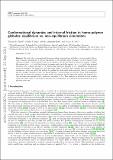Conformational dynamics and internal friction in homopolymer globules: equilibrium vs. non-equilibrium simulations
Author(s)
Einert, Thomas R.; Netz, Roland R.; Sing, Charles E.; Alexander-Katz, Alfredo
DownloadAlexander-Katz_Conformational dynamics.pdf (1.487Mb)
OPEN_ACCESS_POLICY
Open Access Policy
Creative Commons Attribution-Noncommercial-Share Alike
Terms of use
Metadata
Show full item recordAbstract
We study the conformational dynamics within homopolymer globules by solvent-implicit Brownian dynamics simulations. A strong dependence of the internal chain dynamics on the Lennard-Jones cohesion strength ε and the globule size N [subscript G] is observed. We find two distinct dynamical regimes: a liquid-like regime (for ε < εs with fast internal dynamics and a solid-like regime (for ε > ε[subscript s] with slow internal dynamics. The cohesion strength ε[subscript s] of this freezing transition depends on N G . Equilibrium simulations, where we investigate the diffusional chain dynamics within the globule, are compared with non-equilibrium simulations, where we unfold the globule by pulling the chain ends with prescribed velocity (encompassing low enough velocities so that the linear-response, viscous regime is reached). From both simulation protocols we derive the internal viscosity within the globule. In the liquid-like regime the internal friction increases continuously with ε and scales extensive in N [subscript G] . This suggests an internal friction scenario where the entire chain (or an extensive fraction thereof) takes part in conformational reorganization of the globular structure.
Date issued
2011-12Department
Massachusetts Institute of Technology. Department of Materials Science and EngineeringJournal
The European Physical Journal E
Publisher
Springer-Verlag
Citation
Einert, T. R., C. E. Sing, A. Alexander-Katz, and R. R. Netz. Conformational Dynamics and Internal Friction in Homopolymer Globules: Equilibrium Vs. Non-equilibrium Simulations. The European Physical Journal E 34, no. 12 (December 14, 2011).
Version: Author's final manuscript
ISSN
1292-8941
1292-895X